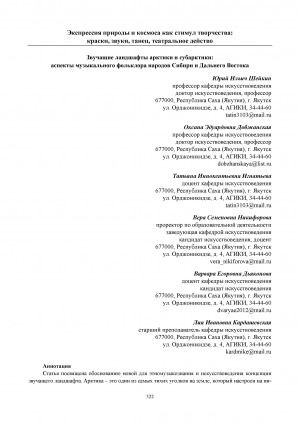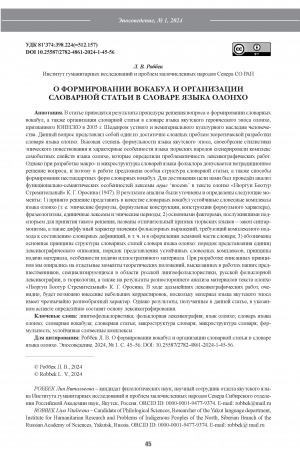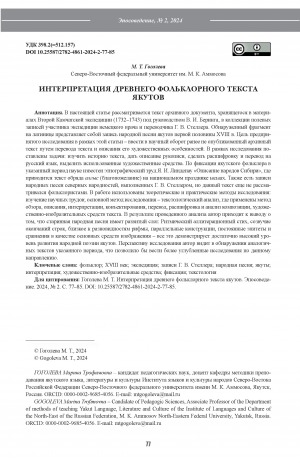- Бурятский (3)
- Чукотский (2)
- Долганский (1)
- Английский (13)
- Эскимоский (3)
- Эвенкийский (6)
- Эвенский (16)
- Французский (2)
- Немецкий (2)
- Корейский (1)
- Мансийский (1)
- Нанайский (1)
- Ненецкий (2)
- Нганасанский (1)
- Нивхский (2)
- Старорусский (1)
- Польский (1)
- Русский (931)
- Латинская графика (5)
- Тунгусский (1)
- Турецкий (3)
- Якутский (400)
- Юкагирский (3)
Количество страниц: 15 с.
The article introduces the concept of sound landscape as a novel methodological approach in the area of Siberian studies for application in research fields such as ethnomusicology and arts history. The Arctic is one of the quietest places on Earth, where the sound sensitivity to the acoustics of nature has been always heightened. This is reflected in the musical folklore of peoples inhabiting the Arctic. The authors explicate the concept of sound landscape as a complex phenomenon comprised of several layers: the intonational interaction with nature (i.e. the ways in which voices of nature are embedded in sounds and understood in rites and folklore); the projection of human personality onto the outer world (as reflected in epics or rituals); and the use of imitative phonoinstruments. The authors argue that the approach elaborated enables researchers to see and examine the elusive sonic aspects of culture that have often remained unnoticed.
Шейкин, Ю. И. Звучащий ландшафт Арктики / Ю. И. Шейкин, О. Э. Добжанская, В. С. Никифорова // Этнографическое обозрение. - 2016, N 4, июль-август. - С. 30-44.
Количество страниц: 6 с.
The article is devoted to the substantiation of the concept of the sounding landscape, which is new for ethnomusicology and art history. The Arctic is one of the quietest corners on earth, which is attuned to an intonational understanding of nature. This is reflected in the musical folklore of the peoples of the Arctic and Subarctic. The authors distinguish three main layers in the sounding landscape, which differ in their function and intonation. The first layer is the intonational interaction with nature (imitation of the sounds of nature in onomatopoeia and onomatopoeia with the help of the human voice, their interpretation in ritual, song and epic intonation). The second layer is associated with the projection of a person's personality outside, communication with nature in lyrical, epic, ritual genres. The third layer is associated with the creation of special material objects for sound communication with nature (imitation phono instruments, decoys, etc.). The authors interpret the concept of the sounding landscape on the material of the musical folklore of the peoples of Siberia and the Far East (Chukchi, Ude, Yukagir, Evenkis, Sakha, Nganasan). According to the authors of the article, the methodology of studying the sounding landscape of the Arctic and Subarctic allows us to identify and study those aspects of intonation-acoustic culture that were often not in the focus of attention of researchers, but remained "behind the scenes".
Звучащие ландшафты Арктики и Субарктики: аспекты музыкального фольклора народов Сибири и Дальнего Востока / Ю. И. Шейкин, О. Э. Добжанская, Т. И. Игнатьева [и др.] ; Арктический государственный институт культуры и искусств // Российское дальневосточное искусство и мир. Международная научная конференция 2021: материалы конференции, Владивосток, Дальневосточный федеральныйуниверситет 8-9 апреля 2021 года / [редакционная коллегия: Г. В. Алексеева, Н. В. Толстая, Н. А. Федоровская ; рецензенты: Т. В. Краюшкина, Г. Г. Ермак]. - Владивосток : Дальневосточный федеральный университет, 2022. - 1 файл (374 с. ; 19,9 Мб). - С. 322-327.
Количество страниц: 8 с.
Ларионова, А. С. Особенности работы М. Н. Жиркова с корреспондентами / А. С. Ларионова // Собирательская деятельность корреспондента Е. Е. Лукина в контексте становления якутской полевой фольклористики : сборник статей и материалов. - Якутск : ИГИ и ПМНС СО РАН, 2019. - ISBN 978-5-902198-49-9. - С. 54-61.
DOI: 10.25693/EELukin.2019.ONA
Количество страниц: 3 с.
Петров, А. А. О запевных словах эвенского кругового танца хэде / А. А. Петров // Круговые танцы народов Евразии: актуальные вопросы изучения, сохранения, укрепления традиций. - Якутск : Издательский дом СВФУ, 2024. - ISBN 978-5-7513-3713-1. - С. 229-235.
Количество страниц: 16 с.
This paper analyzes the song inclusions in the tales of Forest Yukaghirs, the content of such pieces, their purposes, and origin. Song segments are found in animal tales, including mythological ones, fairy tales about a Fabulous Old Man-eater, and everyday fairy tales. The song inclusions mostly convey the monological speech of the characters and include lexical repetitions. The song inclusions considered are mainly the magical appeal of one hero to another, a personal story, or a real personal situation. Some of them can be characterized as personal songs. Characters endowed with supernatural powers use the song as a magical ritual. These characters include heroes with shamanic powers and the ogre giant, the Fabulous Old Man. The magical potential of the song, aimed at summoning and embodying something, can also be evoked by ordinary people, even unintentionally. Songs-appeals of some characters to others are performed in magical situations, facilitating their manifestation. The fairy tales provide indirect indications of the shamanic power of the singing characters. Alternatively, the songs addressed to other persons can be performed by ordinary characters, usually represented by animals. Songs as personal narratives or real personal situations can be found mainly in the tales about animals. The song inclusions are based on the representations of shamanic activity, magical abilities, and the song type of storytelling, as evidenced by the existence of both non-fairy and fairy tale Yukaghir prose.
Прокопьева, П. Е. Песенные вставки в сказочном фольклоре лесных юкагиров / Е. П. Прасковья ; Институт гуманитарных исследований и проблем малочисленных народов Севера // Сибирский филологический журнал. - 2023. - N 2. - С. 19-34. - DOI: 10.17223/18137083/83/2
DOI: 10.17223/18137083/83/2
Количество страниц: 12 с.
The article presents the result of the procedure for resolving the issue of forming dictionary vocables, as well as organizing a dictionary entry in the dictionary of the language of the Yakut heroic epic Olonkho, proclaimed by UNESCO in 2005 as a masterpiece of the oral and intangible cultural heritage of humanity. The question was one of the rather complex problems in the theoretical development of a dictionary of the Olonkho language. The high degree of formulaicity of the language of the Yakut epic, the originality of the stylistics of the epic narrative and the characteristic features of the language of the Turkic peoples generated a complex of original properties of the Olonkho language, which determined the problematic character of lexicographic works. However, when developing the macro- and microstructure of dictionaries of the language of folklore, an unconventional solution to the problem is allowed, and therefore the work proposes a special structure of a dictionary entry, as well as methods for forming non-standard forms of dictionary vocables. To achieve the goal, we analyzed the functional and semantic features of the lexeme aghys ʻeightʼ in the olonkho text Nurgun Bootur the Swift by K. G. Orosin (1947). As a result of the analysis, the following points were clarified and determined: 1. it was decided to present stable verbal complexes of the Olonkho language (i. e. epic formulas, formulaic constructions, constructions of a formulaic nature), phraseological units, single lexemes and epic periods as vocabulary vocables. The main factors that served as support for making such a decision were the distinctive feature of the Turkic languages - the law of synharmonism, as well as the diffuse nature of the meaning of folk expressions, which requires an integrated approach to the compilation of dictionary definitions, including in the design of the lemma part of the dictionary. The basic principles of the structure of dictionary entries in the Olonkho language dictionary are indicated: the order of presentation of units of lexicographic description, the order of presentation of stable verbal complexes, principles of presentation of material, features of presentation of illustrative material. In developing the described principles, we relied on individual aspects of the theoretical positions expressed in the works of our predecessors, specializing in the field of Russian lingua-folkloristics, Russian folklore lexicography, in Turkic studies, as well as the result of a comprehensive analysis of materials from the K. G. Orosin’s olonkho text of Nurgun Bootur the Swift . In the course of further lexicographical work, it will obviously be possible to make minor adjustments, since the language material of the Yakut epic is extremely diverse. However, the result obtained in this article, in this aspect, will definitely form the basis of lexicography.
Роббек, Л. В. О формировании вокабул и организации словарной статьи в словаре языка олонхо / Л. В. Роббек ; Институт гуманитарных исследований и проблем малочисленных народов Севера // Вестник Северо-Восточного федеральногоуниверситета им. М. К. Аммосова. Серия: Эпосоведение. - 2024. - N 1 (33). - С. 45-56. - DOI: 10.25587/2782-4861-2024-1-45-56
DOI: 10.25587/2782-4861-2024-1-45-56
Количество страниц: 10 с.
This article is devoted to the identification of universal and national values in the epic texts Mighty Er Sogotokh and Maadai-Kara . The relevance of the study of the problem is due to the growing interest in the comparative study of linguistic and cultural features in multi-system languages based on the material of epic texts. The following methods are used in the work: the continuous sampling method, linguistic and cultural and interpretative analyses, and the comparative method. The material for the analysis was extracted by a continuous sampling method from the original texts of epic tales, provided with a line-by-line translation into Russian. The purpose of the work is to identify and describe universal and national-specific attitudes in the value perception of the surrounding world, reflected in the linguistic units of epic tales. The study revealed that both texts enshrine such basic values as family, attention to people, safety, respect for parents, Homeland, justice, health, etc., which show their relative stability in the temporal and spatial dimensions. The vital, cultural, moral, spiritual, terminal, and other values available in each community exist collectively in one context. It is also revealed that the life-affirming imperative is translated from the position of the characters, for example, the father and mother of the main characters or on behalf of the mistress of Altai, who have significant experience in pragmatic communication with the outside world and the nature of the worldview of the inhabitants of the space of their existence. Thus, a general picture of values is formed for transmission to the inexperienced, the young, or those who are looking for value supports to know themselves and others, are in search of answers to the multifaceted questions of human existence, etc. The prospect of further work is seen in a more detailed and in-depth development of the dominant values that determine the norms of behavior in various discursive practices of related languages.
Николаева, Т. Н. Лингвокультурные ценности в эпическом дискурсе (на материале якутского и алтайского эпических текстов) / Т. Н. Николаева ; Северо-Восточный федеральный университет им. М. К. Аммосова // Вестник Северо-Восточного федерального университета им. М. К. Аммосова. Серия "Эпосоведение". - 2024. - N 2 (34). - С. 86-95. - DOI: 10.25587/2782-4861-2024-2-86-95
DOI: 10.25587/2782-4861-2024-2-86-95
Количество страниц: 9 с.
The author deals with the text of an archival document discovered in the materials of the Second Kamchatka expedition led by Vitus Bering, in the collection of field notes of the expedition member, the German doctor and translator G. W. Steller. This fragment in Latin is a recording of a Yakut folk song of the first half of the 18th century. The purpose of this article is to introduce a previously unpublished archival text into scientific circulation by translating the text and describing its artistic features. As part of the research, the following tasks were set: to study the history of the text, give a description of the manuscript, transcribe and translate it into Russian and highlight the artistic means used. According to the fixation of Yakut folklore in the specified period is known to science the ethnographic work of J. J. Lindenau “Description of the nations of Siberia,” which contains the text of the algys ritual on the Ysekh holiday. There are also recordings of folk songs of northern nations performed by G. W. Steller, but this text has not yet been examined by folklorists. The work uses theoretical and practical research methods as: study of scientific works, the main research method is textual analysis, which uses the method of review, description, interpretation, connection, translation, decoding and analysis of the composition, artistic and visual means of the text. The author concludes that the ancient folk song has a developed syllable. Rhythmic alliterative verse, consonance of line endings close to varieties of rhyme, parallel constructions, constant epithets and comparisons as the main means of depiction demonstrate a fairly high level of development of Yakut folk poetry. The author sees the prospect of research in the discovery of similar texts of the specified period, which would allow more in-depth research in this area.
Гоголева, М. Т. Интерпретация древнего фольклорного текста якутов / М. Т. Гоголева ; Северо-Восточный федеральный университет им. М. К. Аммосова // Вестник Северо-Восточного федерального университета им. М. К. Аммосова. Серия "Эпосоведение". - 2024. - N 2 (34). - С. 77-85. - DOI: 10.25587/2782-4861-2024-2-77-85
DOI: 10.25587/2782-4861-2024-2-77-85
Количество страниц: 10 с.
The investigation of Russian folklore has not yet been fully institutionalized in literature, cinema, and theater. In Russian literature, for example, there are no novels about Koshchei the Immortal, Ivan the Prince, heroes of Slavic pagan culture and many other characters of this genre. Meanwhile, these are deep, colorful images organically integrated into an equally vivid context. Many great writers, such as Thomas Mann, have written about such gaps. The goal is to identify the main typological characteristics of the Russian epic, which, in our opinion, has been studied in this sense very one-sidedly. The methodology is a comparative analysis of various approaches (mythological, historical, structural, etc.) closely interconnected with the characteristic features and structure of epics. At the same time, considerable attention is the harmonious combination of various motifs of the epic: heroes, Kalik-passers-by, epic time, pagan influences, hyperbolization, etc. An attempt is made not to accept, but to take into account various influences on such studies (pre-revolutionary, post-revolutionary, inspired by the Marxist approach, structural analysis, which began to be used in the study of Russian epic since the 1970s). The Russian epic, thanks to a huge number of historical, social, and cultural connections, naturally interacts with the epics of the republics (union and autonomous) that were part of the former USSR, which opens up wide opportunities for comparative studies of various types. Paths are outlined for a comparative analysis of the Russian epic with the epics of the East Slavic peoples, as well as with the Yakut heroic epic Olonkho. The authors' further plans involve continuing the study of Russian folklore in the genre of fairy tales and the field of culture of Slavic paganism. The first of them has been studied quite fully, but the structural and systemic approaches to research need to be further developed. The culture of Slavic paganism is a little-studied area where there are still no established approaches, and there are different points of view on many issues. Here you can apply the methodological approaches outlined in our monograph “Philosophy of Olonkho”.
Кожевников, Н. Н. Основания и компаративистский анализ русского эпоса / Кожевников Н. Н., Данилова В. С. ; Северо-Восточный федеральный университетим. М. К. Аммосова // Вестник Северо-Восточного федерального университета им. М. К. Аммосова. Серия "Эпосоведение". - 2024. - N 2 (34). - С. 67-76. - DOI: 10.25587/2782-4861-2024-2-67-76
DOI: 10.25587/2782-4861-2024-2-67-76
Количество страниц: 8 с.
- Общественные науки. Образование > Фольклор,
- Искусство. Фотография. Музыка. Игры. Спорт > Развлечения. Зрелища. Игры > Театр. Сценическое искусство,
- НАУКА ЯКУТИИ > ОБЩЕСТВЕННЫЕ НАУКИ > Этнография. Обычаи. Жизнь народа. Нравы,
- НАУКА ЯКУТИИ > ИСКУССТВО. ФОТОГРАФИЯ. МУЗЫКА. ИГРЫ. СПОРТ > Развлечения. Зрелища. Игры > Театр. Сценическое искусство.
The novelty of the research lies in the literary analysis of the performances of the Sakha theater, the definition of epic content in modern stage works. For the first time, the material of the creative rethinking of Western European, Russian and Yakut drama on the ways of forming an aesthetic manifesto of the national theater is summarized. The purpose of the study is to identify the epic code as a key that reveals the role and mission of the Sakha theater in the spiritual culture of the people. The objectives of the research include: 1) to reveal the functionality of the local content of Western European drama by W. Shakespeare, E. T. A. Hoffmann and B. Brecht, whose plays made it possible to creatively decipher the code of the epic heritage of the Sakha people; 2) consider the interaction of theater and prose in the experience of director's staging. The research used methods of historical, literary, comparative and contextual analysis. The study revealed the process of theater's movement towards a synthesis of classical and epic theatrical art. The significance of working with the prose works of P. Oyunsky,S. Kurilov, Ch. Aitmatov as a conceptual part of the manifesto of the Yakut theater is assessed.
Желобцова, С. Ф. О генезисе эпического кода в эстетике Саха театра / С. Ф. Желобцова, С. Н. Барашкова ; Северо-Восточный федеральный университет им. М. К. Аммосова // Вестник Северо-Восточного федерального университета им. М. К. Аммосова. Серия "Вопросы национальных литератур". - 2024. - N 1 (13). - С. 75–82. - DOI: 10.25587/2782-6635-2024-1-75-82
DOI: 10.25587/2782-6635-2024-1-75-82









